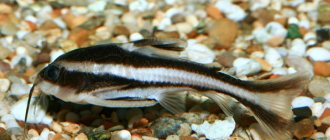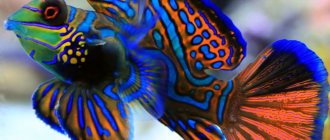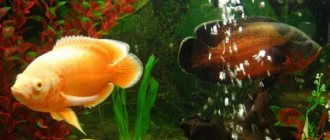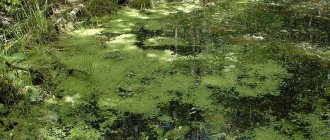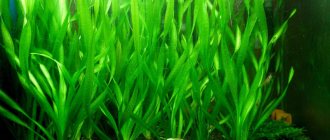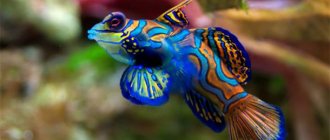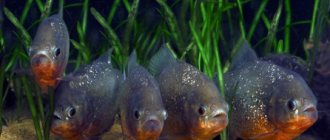Variety of aquarium fish by color. Aquarium fish and their behavior according to the variety. The most unusual and exotic aquarium fish.
- Aquarium fish can attract the attention of even the most indifferent people. It is simply impossible to pass by a beautiful aquarium with clear water and fish smoothly moving through it
- It is believed that contemplating an aquarium and its inhabitants calms the nerves and puts one in a balanced mood.
- In this article we will try to figure out what types and colors of aquarium fish there are, what behavior patterns these fish have, and how best to organize their living together in the same aquarium
White aquarium fish
White aquarium fish
- White aquarium fish are considered quite rare and expensive. This is explained by the fact that the albinism gene is not dominant, and therefore is very quickly lost in subsequent generations. Based on this, breeding white fish is not an easy task.
- The difficulty of keeping albino fish is that almost all fish diseases, as a rule, manifest themselves through a light coating on the surface of the scales. It is very difficult to notice such manifestations of the disease on fish with a white or transparent color.
- In addition, in order to have a beautiful aquarium with white fish, it is advisable to select a dark background that matches them. This way the fish will be more clearly visible and will not blend in with other elements of the aquarium.
White goldfish
White goldfish
Among goldfish you can also find albino fish: these are representatives of such breeds as Shubunkin, Comet, Telescopes, Eyes and Orandas.
Small fish
Silver mollies
Guppy white prince
Fish of the poeciliaceae family can also be albino. Their names always include a color: silver molly, White Prince guppy, Pearl scarlet guppy and Bulgarian white swordtail.
Catfish
Albino catfish
Speckled white corydoras catfish are very friendly and calm inhabitants of the bottom of the aquarium.
Such fish are found in white and golden tint.
Cockerels
White cockerels
An incredibly beautiful fish is the white cockerel. His chic tail and fins will not leave anyone indifferent.
White angelfish
White angelfish
These charming fish are also called “angel fish”.
White cichlids
Cichlid White Prince
White cichlids, like black ones, are quite aggressive fish, so it is best to keep them in a species aquarium.
Albino cyclids include pseudotropheus and astronotus.
Other types of fish
The description of the surgeon family mentions more than 40 species. They differ only in the length of the body and the color of the scales. The habitat and body shape are almost identical.
The following species are suitable for aquarium cultivation:
- Arab surgeon . In its natural environment it is found on reef shallows in the Indian Ocean and in the waters of the Persian Gulf. It is characterized by pronounced territoriality and aggressive behavior. Under natural conditions, the body length can be 40 cm. The color of the scales is gray with characteristic lines or patterns of purple. In the aquarium, males compete with other fish, with the exception of their own harem. Arab surgeons eat shellfish as food.
- Zebrasoma . The genus consists of 7 varieties, but yellow varieties are used for aquarium conditions. Individuals are found on coral reefs in the Pacific and Indian oceans, the Red Sea and the Persian Gulf. Due to rampant poaching, the species is considered rare and endangered. The maximum length of the fish in the wild is 40 cm, and in a container - 20-25 cm. To breed the species, a vessel with a volume of 0.4 m³ is required. Zebrasomas get along well with other aquarium inhabitants. The basis of the diet is plants growing on rocks.
- White-breasted surgeon . Found in the Pacific subtropics and the Indian Ocean. The body is colored blue or bright blue. The fins on the back are yellow, while the ventral and anal fins are white. The color of the head and lips is dark purple. Adults show aggression towards other animals that swim into their territory. In an aquarium they can grow up to 30-35 cm in length. They prefer to lead a gregarious lifestyle and feel comfortable in containers with a volume of 1 m³ or more. Being an omnivorous fish, they eat algae and plankton.
- Japanese surgeon . Found in the western Pacific in shallow waters. The body is gray-brown in color, and in the area of the anal and dorsal fin there are lemon-yellow stripes. The fin on the tail is white with a characteristic neon edging. The maximum length is 14-15 cm. The fish feeds on vegetation, but can eat mussels and shrimp. When kept with other relatives, it shows aggression. One Japanese surgeon requires a 400 liter aquarium.
- Striped tang . Found on coral reefs in tropical and subtropical waters. In the natural environment it grows up to 40 cm, and in artificial conditions the maximum size is 25-30 cm. The body is light blue, and the lateral and dorsal fins are neon.
- Chocolate surgeon . The homeland of the species is considered to be the waters of the Indo-Pacific basin, with the exception of the Hawaiian Islands. In the wild it grows up to 25 cm in length, and in aquariums - up to 16-18 cm. The body is colored gray with a brown tint. The fish lead a solitary life or live in a harem. In the first case, one individual requires an aquarium of 250-300 liters. In the second - 400 liters.
Exotic aquarium fish, photos with names
Among those fish that were mentioned above, there were a lot of exotic fish. But these are not all the strange fish that you can keep right at home today. Here are the names and photos of the most beautiful and unusual exotic aquarium fish:
Elephant fish
glass perch
Tetraodons or four-teeth
Macrognath
Silver arowana (dragon fish)
Skat Motoro
Red-bellied Piranha
Mastocembelus redstripe
Mastocembelus armatus armored
Botia marble
Fish knife Khitala
Leporin tape
Arabian butterfly fish
Tamarin yellow
Florida armored pike
Surgeon olive
Chromis
Royal Gramma
Gramma blackhead
Queen Nyasa
Falsechromis violet
Falsechromis Friedman
Fundulopanax
Heufrich's Nemateleotris
Bleeker's Parrotfish
Green clown goby
Gymnothorax funebris or green moray eel
Snipe wrasse
Bristle-tailed unicorn
Rose-tailed Triggerfish
Thalassoma lunarum
Green tamarin
Acantophthalmus
Reproduction
The Nannakara neon blue, like other cichlid species, produces offspring by spawning. All stages of the breeding process are standard. Adults can cope with fry on their own, without outside intervention, even if they are kept in a community aquarium. There is no need to create special conditions for the female to spawn.
In practice, there is nothing difficult in breeding Nannakara. It is enough to adhere to the usual conditions of the aquatic environment - normal hardness, temperature and acidity.
During one spawning, the female chooses the darkest, most distant, protected area of the aquarium under flat stones, where she lays about 50–300 eggs. The male's task is to quickly fertilize them. This completes his mission, and further care falls on the female. She not only prevents other fish from approaching the future offspring, but also periodically fans the eggs with her fins, creating vibrations and movements of the water masses.
After three days, the female, along with the eggs, moves into a pre-prepared hole in the aquarium soil. The fry will appear in five days. First, they, together with their mother, will master the available water space, and then begin to spread out as soon as they receive their first survival lessons. At this stage, you can begin to provide food for the fry in the form of artemia or rotifers.
During the breeding season, couples can behave differently. Sometimes a mother jealously protects her future offspring from everyone, including the father. He makes attempts to jump outside the aquarium so as not to be eaten - in this case it is better to temporarily relocate him. But more often, parents jointly monitor the eggs, and then protect and train the young by taking targeted walks.
Sexual maturity of fish occurs at the age of 10-12 months. Under normal conditions, nannakara spawning occurs several times throughout the year. But if necessary, this process can be controlled and artificially slowed down. To do this, it is enough to maintain a constant water temperature.
Calm aquarium fish. Peaceful aquarium fish
Peaceful and calm aquarium fish
Representatives of the following families are distinguished by their calm behavior and peaceful disposition:
- Catfish. Almost all catfish are very friendly. They swim along the bottom and have nothing to share with other inhabitants of the aquarium, who spend most of their time in the water column. Among the most popular peaceful catfish are speckled catfish, corydoras, glass catfish and ancistrus
- Characinaceae. The characin family includes small, friendly fish that live in schools. As a rule, they have quite attractive bright colors and do not require special care. The most common aquarium characins in our country include thornets, neons, tetras and pristellas
- Cyprinids. Peaceful representatives of the carp family include aquarium fish such as zebrafish, barb, cardinal and rasbora
- Labyrinthine. This subgroup of fish differs from the rest in the specific structure of their body. This explains the unusual shape of the fish. The most popular aquarium fish of this family are gourami, bettas, macropods and lapius.
- Cichlids. In general, cichlids are considered quite capricious and aggressive fish. However, even among them there are a number of fish that can get along with other types of fish. To properly place cichlids in the same aquarium with other fish, it is worth taking into account their habits and equipping special burrows and shelters in it. The following representatives of the cichlid family can be called quite friendly: blue dolphin, cichlasoma and aulonocara
Description of the Royal Surgeon
The Royal Surgeon is one of the most sought after members of the family.
They are distinguished by their exotic appearance, increased activity and gluttony. Individuals spend most of their time searching for food. Under natural conditions, their preferred lifestyle and habitat is ocean waters. They are distinguished by an elliptical body shape and a wide variety of colors.
The scale color palette varies from light blue to dark blue with purple patterns.
The tail fin is lemon yellow with a flesh-colored mesh pattern along the edges. Depending on the conditions, part of the belly and fins become yellowish in color.
The mouth is small with a characteristic seal in the front. The eye size is quite large, and the average length of adult specimens in captivity reaches 20-22 cm.
During the daytime, representatives of the species demonstrate high activity. Young individuals form flocks, while adults prefer a solitary lifestyle, with the exception of harems.
Blue surgeons are characterized by pronounced territoriality, but outside their territory they do not show aggression towards other fish.
Small specimens prefer to eat aquarium plants and make camps in the vegetation. When setting up burrows, the blue tang fish prefers natural shelters.
The maximum lifespan in captivity is 12-20 years.
Aquarium predator fish
Aquarium fish-predators
First of all, it is worth saying that there are simply no purebred predators among aquarium fish. Since only an animal that feeds exclusively on meat can be called predatory. Those fish that prefer to feast on other fish are always not against plant food.
Among the most famous aggressors living in home aquariums are:
Astronotus
Cichlid knife
Piranhas
Sacbranch catfish
Tetradon
Turquoise Akara
Krenicichla cordis punctata
Blue discus
Polypterus
Snakehead
Labeo bicolor
Ctenopoma Leopardova
Mastacember armatus
Monodactyl dark
Pangasius Skat Motoro
Indian knife
Why is it called that?
Thanks to these spines, in a “combat” state, sharp as scalpels, the fish is called a surgeon.
While nothing threatens her, the spines are hidden in special recesses in the body, covered with bright orange covers, which can be mistaken for an extra pair of fins. But in case of danger, the spikes extend and become perpendicular to the body. When attacking, the surgeon quickly rushes past the enemy, striking him with a poisoned tip.
Interesting fact: tourists vacationing on the sea coasts most often turn to doctors because of cuts on their legs caused by surgeons.
Yandex pictures
Unpretentious aquarium fish
Unpretentious aquarium fish
The least exotic fish and small-sized fish have always been considered the most unpretentious. Here are the Top 15 such fish:
- Guppy
- Swordtails
- Pecilia
- Mollies
- Catfish corridors
- Characin tetras
- Ternetia
- Danio rerio
- Torakatum
- Gourami
- Barbs
- Cardinals
- Cockerels
- Macropods
- Neons
Danger to humans
The harmless appearance of a bright fish frolicking in shallow water often evokes a desire to get to know it better; Beginning divers sometimes forget why it got its name. Why is this meeting dangerous for a person?
The surgeonfish looks slow and even clumsy. But strong pectoral fins help her, if necessary, to instantly turn around and attack, and for no apparent reason. The spikes rip through safety shoes and cause deep cuts to the person. In addition, they are saturated with toxic mucus, which, when it gets into the wound, causes pain and inflammation.
In addition to intoxication and infection, a victim who does not receive timely medical attention is at risk of severe blood loss. If the attack occurred far from the shore, blood that gets into the water can attract sharks to the scene.
Therefore, long before entering the sea for the first time, it is useful to learn about the habits of the local fauna, so as not to get close to its potentially dangerous representatives.
Interesting fact: surgeonfish are actually very patient. She can withstand the pestering of annoying tourists for quite a long time, sailing to a safe distance for herself. But he does not tolerate attempts to stroke himself, as well as other familiarity.
Yandex pictures
Meteorite 4.5 billion years old
The Fukang meteorite was discovered in 2000 in the mountains near the city of the same name in China. It is believed to be more than 4.5 billion years old and weighs 20 kilograms. Fukang is a pallasite that is a matrix of iron and nickel interspersed with olivine crystals.
It is assumed that the meteorite was formed during the birth of the solar system. High temperatures could fuse the olivine with the metal, forming a matrix. It is estimated that less than 1% of all meteorites are considered pallasites. This makes it one of the greatest meteorites discovered in the 21st century. The meteorite was divided into many parts and sold at auction.
Scientists are still struggling with the mystery of what part of the solar system this cobblestone could have come to us from.
Interesting Facts
The Atlantic giant is the largest bony fish and has practically no enemies; few people dare to attack a 2-5-meter fish. Tasty, valuable meat, as well as record sizes, motivate many fishermen to take on risky fishing, but after the photo shoot, most of the caught trophies were released back into the sea. There are many rumors and legends about the giant fish, here are some of them:
- The fight with one marlin can last more than 30 hours. In the hope of getting rid of the gear, the fish swims at high speed or goes to depth until it becomes exhausted or breaks the gear.
- A spear-shaped jaw was found in the bottom of one sailboat, piercing the hull and a thick layer of oak wood. This fact speaks about the strength and speed of the predator, as well as the strength of the spear.
- A sailfish weighing 700 kg was caught off the coast of Peru.
Merlin is the largest bony fish and has virtually no enemies - The record weight of the fish was recorded at the beginning of the century and was 818 kg with a body length from the edge of the tail to the tip of the spear - 5 meters.
- The maximum age of swallowtails reaches 27 years for females and 18 years for males.
- The hunting speed is 110 km/h, the fish deftly jump out of the water, piercing flying fish with their spears in flight.
- Predators often attack ships and boats for fun.
- The distance of seasonal migrations reaches 7 thousand miles.
- Of the natural enemies, only sharks can be distinguished.
Marlin reproduce in small schools; individuals that have reached 2-4 years of age are considered sexually mature. The mating season occurs at the beginning of autumn; after fertilization, the female is able to lay up to 7 million eggs.
Young fry are carried by the current to different parts of the Atlantic Ocean, many die from attacks by larger fish.
https://youtube.com/watch?v=P7KZrt1E3XQ
Lifestyle
The surgeonfish is active mainly during the daytime.
Interesting fact: some idae change color with the onset of darkness: they turn pale, darken, or become covered with new spots and stripes.
They easily get along with their own kind and with other reef inhabitants. This family has its own distinctive behavioral characteristics.
- In their habitat, surgeons are distributed evenly, without interfering with each other, as if respecting the personal boundaries of their relatives
- They equally zealously guard both their territory and group space (when they gather in schools for spawning)
- We can call surgeons social beings: in their environment there is a clearly expressed division into ranks, within which unconditional subordination is carried out. That is why they get along with each other and others easily.
- Young surgeons grow up independently, separately from adults
- Each population maintains its numbers by regulating the birth rate of new individuals
- By their very existence, lifestyle, and eating habits, surgeons maintain the biological balance of their environment. By eating the algal cover of reefs, they help the vital activity and distribution of corals.
The last circumstance is especially important. Corals are home to many marine life. The possible destruction of reefs is a step towards environmental disaster, so the role of surgeons in the ecosystem is very important.
Yandex pictures
How much are?
In Russia, one fish costs from 1,500 to 5,000 rubles. An aquarium for her will cost from six thousand, excluding additional equipment, corals, plants and soil. A separate expense item is sea water or sea salt.
Mandarin duck is a fish for experienced users. It is difficult to create suitable conditions for her, and even more difficult to feed her. The sea mouse is proof of the aquarist's skills. Only a master can raise this beautiful bright fish. If you carefully control every aspect of your tangerine goby's life, a healthy and happy fish will delight you for a long time.
Do you think the game is worth the effort or should such sensitive animals remain in nature?
If you already have experience keeping this delicate fish, then reading about it would be extremely interesting.
Seed bank of all existing plants
This seed bank contains a staggering 930,000 varieties of food crop seeds. The repository holds the title of "the world's largest collection of agricultural biodiversity." The building, more like a life-saving, impregnable bunker, is located deep in the bowels of the Norwegian archipelago of Spitsbergen. Ice Mountain is located on an island above the Arctic Circle between Norway and the North Pole.
The main purpose of this place is to save seeds in the event of an apocalyptic event or global catastrophe. The location is far from places that are subject to war, terror and natural disasters. The bank consists of three storage facilities, and the seeds themselves are stored at subzero temperatures. Seeds are stored in vacuum silver bags and test tubes. These boxes are key to human survival and the future of global food security.
Considering the true purpose of the storage facility and the conditions of terrible secrecy, it is difficult to imagine what else could be stored within the walls of this “fort.” It is quite possible that humanity’s reserves may contain seeds of more than just plants...
Found a violation? Report content
Breeding
Despite the fact that aquarists for a long time could not reveal the secret of successful reproduction of neons, there is now access to a large amount of information about proper spawning, so with a little preparation, anyone can reproduce neons.
Neon breeding must be strictly controlled to avoid endangering the eggs. Producers must be placed in separate containers several weeks in advance and intensively fed with high-protein feed.
Weakly expressed sexual dimorphism in normal times is replaced by more clear sexual differences: females are rounded in the abdomen, and in males the swim bladder moves towards the anus.
Before placing a pair of neons for spawning, it is advisable to give them several short dates so that the fish get used to each other. The female is able to postpone play weekly, while the male is ready to fertilize her 2 times less often.
The minimum volume of an aquarium for neon spawning is 30-50 liters. Soil is not required. Stable water parameters are required for maximum egg survival. The temperature must be raised to 25-26°C. The water used is soft (2-4°dGH) and slightly acidic with pH= 6.5-7. As a spawning substrate, you can put several branches of Java moss.
It is best to introduce neons ready for spawning into the aquarium several hours before turning off the lights. Two males are usually placed next to the female, who begin an immediate attack on the female. The more agile male will participate in breeding. The pair circles above the leaves of living plants, where the female randomly lays eggs, which are attached to parts of the plants. The spawners must be removed after the end of spawning so that the eggs are not damaged.
Not every egg is destined to become a fry. Many of them will not ripen, some will suffer from fungus. After 9-10 hours, all spoiled eggs must be removed from the aquarium using a pipette. You can also use antifungal medications to save as much caviar as possible.
Incubation ends after 24 hours. The larvae that emerge from the eggs are already able to swim in the upper layers of water for several days. Cyclops, ciliates, and high-quality dry food (TetraMin Baby) are used to feed the fry.
When the fry grow up, it is necessary to move them to a larger aquarium with a slightly higher hardness and a temperature of 24-25°C.
Adviсe
- Monitor the water parameters - a sharp drop in temperature will lead to pale fish and deterioration in health.
- Provide room for swimming.
- Do not feed only protein foods, because then the fish will refuse any other food.
- Neons do not fight and fight for food, so if competition is high, they will remain hungry. Add more food or move the flock to a separate tank.
From the editor: Botsii
Red neons have become widespread due to their easy care and attractive color. When keeping these fish, every aquarist will receive aesthetic pleasure and closeness with nature.
Previous Fish The mutant barbus is a fish with a unique character Next Fish Black Neons is a beautiful fish with a calm temperament
Health
Neons have the ability to lose their brightness during the night. This makes them less accessible to predators. But if the color disappears during the daytime, this may mean that the fish is sick.
The reasons that can affect the health of individuals can be different:
- insufficient oxygen;
- improper feeding (usually overfeeding);
- water temperature (below 15-16 C°);
- water pollution;
- pathogens.
Neons most often suffer from the following diseases:
Plistiphorosis
This is the most common disease that kills neon fish. Its second name is “neon disease”. The fungus affects the muscles. The first symptom is a pale color and neon stripe. As the disease progresses, the fish becomes completely discolored and swims on its side or upside down. Then he dies. The disease is contagious, so the sick individual must be quarantined or killed. There is no treatment.
Saprolegniosis
The causative agent is also a fungus. The main causes of infection are poor aquarium hygiene, unbalanced nutrition and overcrowding. You can notice that the fish is sick by a spore-like coating and gluing of the fins.
False neon disease
The disease received its name due to the common symptoms with plistiphorosis. Only the causative agent is the bacterium Nocardia asteroides. The neon fades, the bright stripe disappears, and a whitish coating appears over the entire surface.
Lifespan
How long a neon fish will live depends directly on the water temperature. Thus, at temperatures above + 26 °C, fish quickly age and live no more than 1.5 years. Therefore, it is better to keep them in water at 20-24 C°. Then their life expectancy will double or triple, that is, the neon will be able to live 3-5 years.
What does it eat?
The surgeon is not a predator: his mouth is small, and his strong jaws and sharp small teeth are designed for plant food.
According to the diet, three groups can be distinguished:
- Those who feed on filamentous and microalgae. Together with food, these fish swallow sand, which helps the food mass to grind, getting into the gizzard. This is characteristic of the olive surgeon, dark, mate.
- They feed on common and calcareous algae, as well as invertebrates crawling on the surface of coral ledges. The sharp teeth of the surgeon easily gnaw and clean coral branches and the upper layers of peripheton - algae and microorganisms. This group does not have a muscular stomach. Example: Minke whale, Pearly white-spotted, Blue golden-backed tang.
- Those who eat the vegetative bodies of algae do not disdain the remains of invertebrates, and at the same time plankton. An example is the white-tailed tang.
In the event of a shortage of food resources, individuals gather in schools to collectively search for food.
Yandex pictures
Feeding
In the natural environment, the blue tang eats zooplankton and algae. In an aquarium, 70% of the diet is plant food. He will get his own greens. To prevent eating algae, give blanched vegetables, oatmeal, and spirulina tablets. Typically, sampa algae contains an excess of chaetomorpha. Send to blue pets.
Feed live or frozen food a couple of times a week. The meat of shrimp, mussels, and sea fish fillets are healthy.
Feed 1-2 times a day. A weekly fasting day is required.
How to prepare soil for an aquarium
Nutrient soil: how to lay it correctly
Good soil has nutritional properties that allow plants to develop and grow properly. The main function of aquarium plants is photosynthesis, during which the water is saturated with oxygen. In turn, the fish receive it in the right portions.
The soil for the aquarium must be laid in 3 layers. Layer 1 – clay or laterite, layer 2 – clay with peat, layer 3 – gravel, pebbles or sand. To prevent the contrast between the layers from being noticeable, it is better to make a 2 cm indentation from the front glass to fill this line with decorative primer. Nutrient substrate is allowed to be placed only in planting areas.
Basic nutrition
Being a predator by nature, the blue marlin fish hunts mackerel, tuna, flying fish, and occasionally squid and cephalopods. Seeing a school of fish, the sailboat accelerates and attacks, stringing the frightened prey onto its spear or swallowing it along the way. Water that gets into the mouth during hunting passes through the gills, enriching the body with oxygen and giving the predator energy.
The mackerel spawning season is considered a real feast , when these places are literally teeming with ray-finned and other predatory fish.
Artistic loaf
This amazing piece of art was created by Californian glassmaker Lauren Stump. A master with 40 years of experience layered colored liquid glass onto a core and meticulously pulled it out until his design was formed into an amazing artifact. Murrine, as the author himself called it, is a cross-section of creative, figurative, hidden images made by combining 2D shapes into 3D objects.
Individual components are produced by melting figurines from liquid glass. The molten glass is further heated and stretched to create an image. For intricate patterns, the process is repeated until the desired look is achieved. Each piece of this amazing art sold for a whopping $5,000.
Blue toothed greenling
The blue-fleshed fish is better known as the bluetooth greenling. It can be found on rocky reefs from Baja California to the Gulf of Alaska. The fish is one of the most formidable predators and gets its unique color thanks to the bile pigment biliverdin. It penetrates the meat of the fish, causing the flesh to turn blue.
Raw greenling meat has a bluish, sometimes turquoise color. It looks like it was mixed with the food coloring we use to color eggs at Easter. But as soon as you put the fish in a hot frying pan, the blue color magically changes to white, and the fish then resembles ordinary pollock or tilapia. This is probably why the blue greenling is not so well known throughout the world. Of course, because only cooks see him blue...
Outsiders are not welcome in this settlement: the Russian community of Old Believers in Alaska
Exotic animals, geography, history and even Latin: a quiz for scholars
Stand for spoons and forks from a regular tin can: master class
Trowel.zh.rf
Want to know everything
This is the fish I came across on the Internet. A very popular photo. I started looking for what kind of miracle of nature this was. I heard mentions of bluefish somewhere, but I couldn’t find any evidence. I was already beginning to doubt the authenticity of the photo, but here is this video:
This eastern blue groper (lat. Achoerodus viridis) from the wrasse family can hardly be called photogenic, but it is a fact that he loves to be photographed.
Just look at the close-up pictures, where he seems to be posing for a photo album about the life of Australian fish. Moreover, he is no stranger to popularity: in 1998, residents of New South Wales chose the eastern blue groper as the emblem of their state.
